|
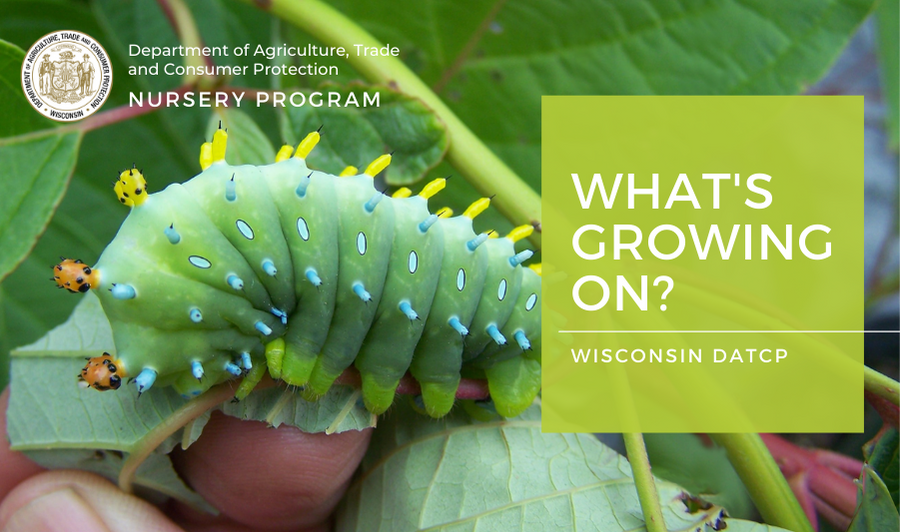 _____________________________________
Dear Wisconsin nurseries, Christmas tree growers, and gardeners:
We hope that you have had a productive, prosperous growing season and are able to recharge and relax with family and friends for Thanksgiving and the upcoming winter holidays.
Take a moment to read through a few updates from the DATCP nursery and other Plant Protection programs. Please send any feedback, questions, or ideas for future e-news updates to datcpnursery@wisconsin.gov.
Having trouble viewing this email? View it as a Web page.
_____________________________________
|
|
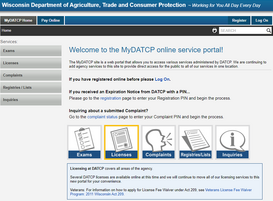
Nursery and Christmas tree licenses for this growing season (LY2024) will expire on February 20, 2024. Expiration notices to renew your license for the next growing season (LY2025) will be emailed in late November. Paper notices will also be mailed out at the end of the month. Please contact us if your email or address has changed since your last renewal.
License renewals can be completed online by using the MyDATCP portal. If you have never used the online license portal, a PIN will be located on your expiration notice so you can register for a MyDATCP account. If you need assistance getting into your account, contact datcpnursery@wisconsin.gov or (608) 224-4574.
Renewing online is an efficient way to update location information, contact information, and sources of plant materials without having to mail in a paper application. Also, once your license is issued, you have the ability to print your license certificate from your computer. No need to wait for the mail.
If you are no longer in business, or if you do not plan to sell perennials next year, please let us know so we can close or suspend your license. This avoids any compliance actions, which may occur for entities who fail to contact us or renew by the February 20, 2024 deadline.
Tips and Reminders:
- Allow pop-ups from MyDATCP
- Only one tab of MyDATCP can be open at a time
- If you have multiple license types, they each need to be renewed individually; but you can pay for them all at once by accessing your invoices from the "My Invoices" tab of MyDATCP
- Watch the video tutorial to walk you through the online renewal process
- Renew your nursery license before Feb. 20 to avoid the 20% late fee, and to check this off your busy to-do list!
For more information, email DATCPnursery@wi.gov, call (608) 224-4574, or visit the Nursery and Christmas tree licensing webpage.
|
_____________________________________
|
|
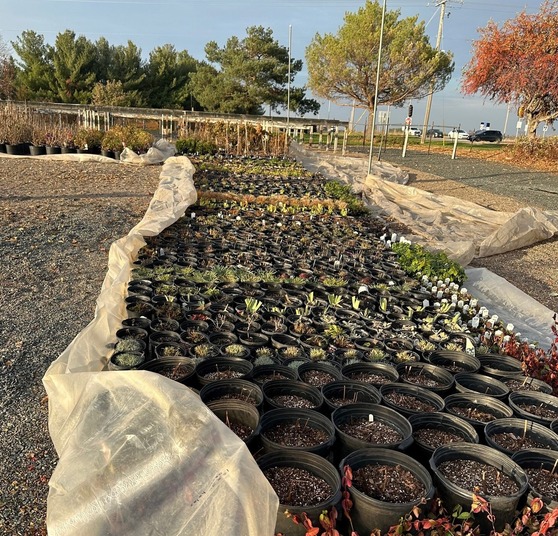 Keeping top open while it's still warm. Will cover with plastic, then straw, then a top layer of plastic anchored down on all sides for winter. | DATCP K. Jerabek
As temperatures drop and business slows, it's a good practice to protect the stock you plan to overwinter. Here are some suggestions to help protect your stock from winter rodent damage.
- Mow all long grass or weeds down low around holding area, as voles and other rodents love to travel under the snow in long grass tunnels during the winter to new feeding areas.
- As tempting as it is to get this job done on a nice warm fall day, don’t cover your woody plants until after November 1 and several hard frosts, so small rodents will have to find someplace else to start their winter hibernation or living quarters.
- You can add extra protection for trees by using tree wrap on the trunks. Trunks should be wrapped before November 1, as some voles will find them in early November and start to girdle them before they are tucked away for winter.
- Encourage natural predators of rodents like fox, hawks, and owls in the surrounding habitat.
- Repellents containing capsaicin or thiram may work, but require frequent reapplication.
- Lethal bait stations are effective but should be used with considerable care not to harm non-target species.
- If possible, plan accordingly to minimize how much woody stock you have to overwinter as you will most likely lose some due to extreme cold while roots are above ground in pots. (Read more overwintering tips here)
- Always remove plant coverings by the end of March, or earlier the further south you are, and remove bait (if used) then, too.
Thanks to one of our readers for asking this question and suggesting it would make a good WGO article!
_____________________________________
|
|
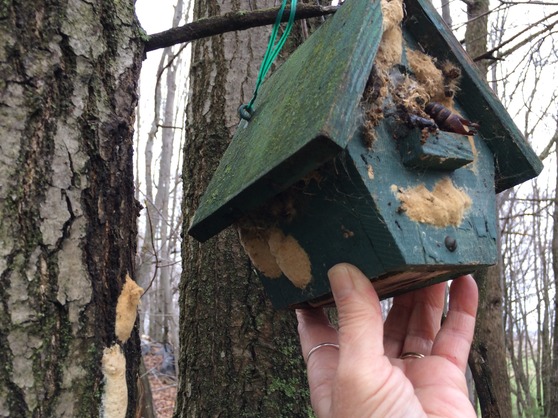 Birdhouse covered in new spongy moth egg masses and spent pupal cases | DATCP M. Wensing
Now that trees are dropping their leaves, it's a great time to go hunting for spongy moth (Lymantria dispar) egg masses. And if you read the article about 2023 record spongy moth populations in the October issue, you know you probably won't have trouble finding some.
Where to look? Spongy moths like to hide their egg masses, so look high, look low, look under loose bark and around bark fissures. They're often laid on the undersides of tree branches and crotches. Oaks are their favorites, so start there. But do not limit your search to trees. They can lay their egg masses on literally anything that's sitting outdoors, including under picnic tables, inside grills, on campers, buildings or the undersides of deer stands, just to name a few! Birdhouses also seem to be a favorite hiding spot.
|
|
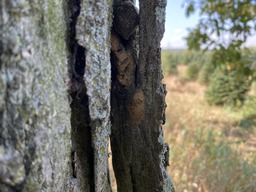 New egg masses hidden behind a loose bark flap | DATCP L. Meils
|
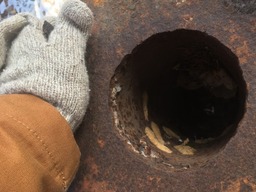 New egg masses laid inside a pipe | DATCP M. Falk
|
|
New egg masses versus old egg masses
New egg masses laid this season are rich or dark tan in color, solid to the touch, and less likely to have chunks taken out (but still can happen). They can have tiny holes from parasitic wasps. Old egg masses have been laid in previous seasons and are no longer a viable life stage. They are often faded or bleached in color, are spongy to the touch, and are more likely to have chunks taken out. |
|
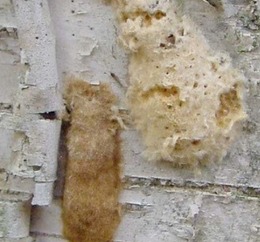 Tan and firm new egg mass on left; bleached and spongy old egg mass on right | DATCP image
|
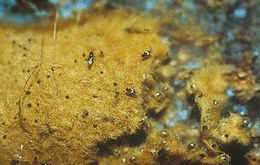 New egg mass with parasitic wasp holes | MSU
|
|
Watch out for spongy moth egg mass look-alikes! Sometimes, what you see may not actually be a spongy moth egg mass. There are lots of other things out there that look quite similar. Inspectors carry close-range binoculars to help make positive IDs. And if you can touch it to confirm if it's firm, spongy, or something else altogether, even better. |
|
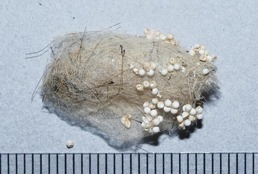 White-marked Tussock Moth spent pupa, cocoon & eggs | BugGuide.net
|
 Fungal growths on tree, not egg masses | DATCP L. Meils
|
|
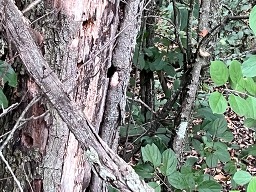 Missing piece of bark, not an egg mass | DATCP M. Wensing
|
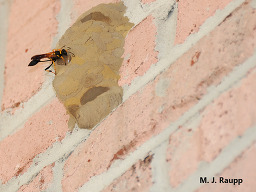 Mud dauber nest | M.J. Raupp, bugoftheweek.com
|
|
|
What to do about them? Depending on the population size and your land use, there are a number of ways to consider controlling your local spongy moth population. Homeowners and woodlot owners can find helpful tips at spongymoth.wi.gov. If you only find a few egg masses, they can simply be scraped into a jar of soapy water. This is worthwhile, since each egg mass can contain 300+ eggs. Nurseries and Christmas tree growers within the federal quarantine, not moving plant material outside of the quarantine, should make efforts to control the population and mitigate the risks of moving any life stages on stock. Nurseries and Christmas tree growers within the federal quarantine that do move plant material out of the federal quarantine are required to sign a Spongy Moth Compliance Agreement (highlighted in the January WGO issue) and take treatment actions, or restrict the movement of potentially infested stock. If you believe you need a spongy moth compliance agreement and don't yet have one, connect with your local nursery inspector to get set up. Compliance agreements are renewed annually and are free of charge.
Spongy moths overwinter as egg masses, hatching out in spring (or around 100-200 GDDB50). That means you have a nice long window over the winter months to find the egg masses and come up with the best plan of action to deal with them. Happy hunting!
_____________________________________
|
|
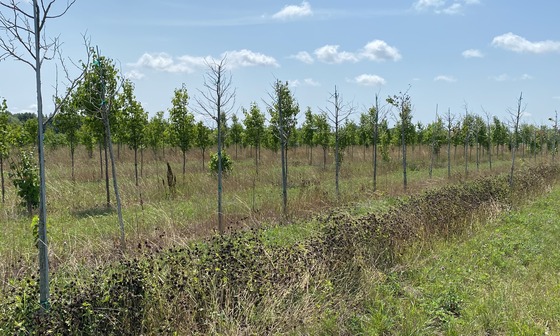 Row of dying Turkish Hazelnut trees infected with EFB | DATCP L. Meils
This summer, a DATCP nursery inspector collected a sample from a field of dying Turkish Hazelnut (Corylus colurna) trees in Jefferson County. The trees had strange symptoms, including cankers that looked like large black “footprints” walking up the twigs. The DATCP Plant Industry Bureau Lab confirmed the disease Eastern filbert blight (EFB), caused by the fungus Anisogramma anomala, as the cause of these symptoms.
|
|
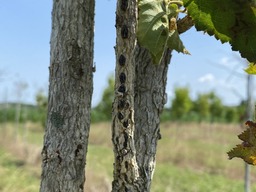 Black “footprints” (fungal cankers) are visible on this twig | DATCP L. Meils
|
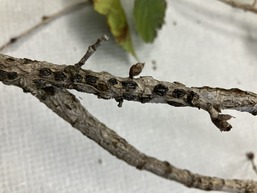 Black fungal cankers visible on twig | DATCP E. Voigt
|
|
|
Eastern filbert blight is a native disease that infects only hazelnuts. Species of hazelnut native to Wisconsin (American and beaked hazelnut) have natural resistance to this disease and generally only show mild symptoms. However, for hazelnut species not native to Wisconsin, including many ornamental varieties, the disease can be lethal. If you are interested in planting hazelnut, consider native species or ornamental cultivars that have been bred for resistance to Eastern filbert blight.
_____________________________________
|
|
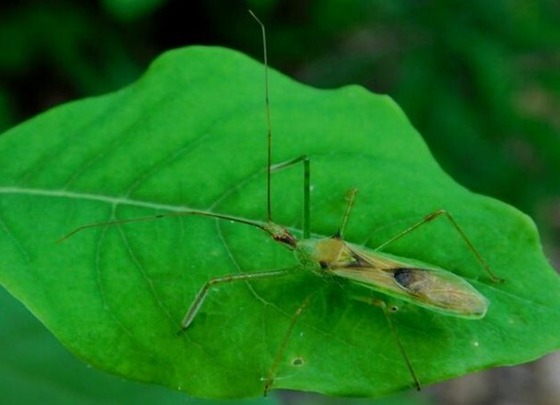 Adult Pale Green Assassin Bug | MO Department of Conservation Julianna Schroeder
This is the third in a series of articles to focus on the natural predators of many of the common pest species found in nurseries and Christmas tree fields.
Assassin bugs are a wide-ranging group of insects in the family Reduviiidae. Typically, they feature long bodies, narrow heads, and are characterized by their formidable rostrum (a long-curved mouthpart) used to inject digestive enzymes into their prey. They can use that rostrum in defense if they are threatened, leaving you with a painful (but not medically significant) bite. So, it is advised not to directly handle these insects. Almost all members of the group are insect predators, so they play a valuable part in controlling many different pest species both native and introduced. There is a small number of species called kissing bugs that do feed on blood, but none of those species occur in Wisconsin.
Assassin bugs are classic examples of insects that undergo incomplete metamorphosis. After hatching from a dense, upright waxy egg case, they emerge as nymphs. Nymphs are an immature form of insects that resemble their adult form, though they lack wings and the ability to procreate. They molt several times over their lives, never entering a pupal stage. Instead, they will directly molt into adults when they reach a sufficient stage of maturity.
One of the most commonly occurring species in Wisconsin is the pale green assassin bug (Zelus luridus). They are stalkers of many pest species that occur on deciduous trees and shrubs Including, aphids, fall webworm, and spongy moth. Interestingly they use a sticky resin produced by glands on their front legs to ensnare prey. After grabbing on to prey with raptorial front legs, they insert their rostrum, injecting a toxic saliva, that both begins digestion of the prey and paralyzes it, aiding feeding.
_____________________________________
|
|
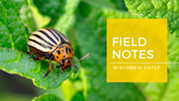
This end-of-season edition of Field Notes summarizes the results of our annual corn, soybeans, and small grains pest surveys. Another report featuring our forest, fruit, and vegetable pest survey results will be issued later this month.
|
_____________________________________

If you are a landowner with two or more acres and live in one of the following states -Illinois, Indiana, Iowa, Kansas, Michigan, Minnesota, Montana, Nebraska, North Dakota, Ohio, Pennsylvania, South Dakota, or Wisconsin, you may qualify for free seed and technical guidance to plant a pollinator habitat on your land.
Register now for the free webinar on November 14 at 7p.m. CST. (A recording will be sent out for those who register but can't make it live).
The Bee & Butterfly Habitat Fund is a nonprofit dedicated to establishing high quality pollinator habitat to ensure pollinator populations thrive.
|
_____________________________________
|
|
|
|
|